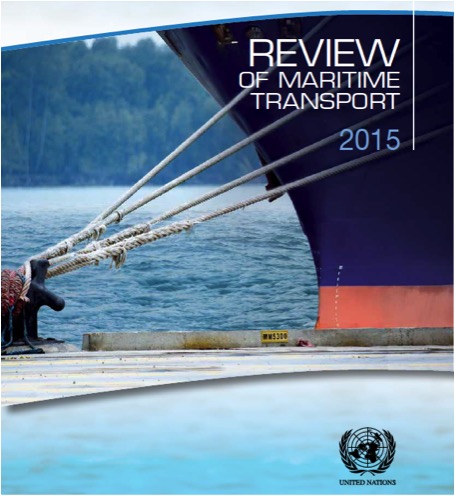Posted on: 19 October 2015
The world’s commercial fleet grew by 3.5 per cent during the 12 months to 1 January 2015, the lowest annual growth rate in over a decade, the UNCTAD Review of Maritime Transport 2015 reveals. At the beginning of the year, the fleet totalled 89,464 vessels, with overall 1.75 million in deadweight tonnage.
Despite its economic troubles, Greece remained the leading ship-owning country, with Greek companies accounting for more than 16 per cent of the world industry, followed by companies from Japan, China, Germany and Singapore. Together, the top five ship-owning countries control more than half of the world deadweight tonnage. Five of the top 10 ship-owning countries are from Asia, four from Europe and one – the United States of America – from continental America.
Over the last decade, China, Hong Kong (China), the Republic of Korea and Singapore have moved up in the ranking of largest ship-owning countries, while Germany, Norway and the United States have a lower market share today than in 2005. In South America, the largest ship-owning country (in deadweight tonnage) continues to be Brazil, followed by Mexico, Chile and Argentina. The African country with the largest fleet ownership is Angola, followed by Nigeria and Egypt.
China ranked highest on the UNCTAD Liner Shipping Connectivity Index, which provides an indicator of a coastal country’s access to the global liner shipping network (the network of regular maritime transport services for containerized cargo). China was followed by Singapore, Hong Kong (China), the Republic of Korea, Malaysia and Germany.
The best-connected countries in Africa are Morocco, Egypt and South Africa, reflecting their positions at the corners of the continent. In Latin America, Panama ranks highest on the Liner Shipping Connectivity Index, benefiting from the Panama Canal and from being at the crossroads of main East–West and North–South routes, followed by Mexico, Colombia and Brazil. The 10 economies that rank lowest on the Index are all island States, reflecting their low-trade volumes and remoteness.
The share of global goods loaded at developing country seaports was estimated at 60 per cent in 2014, while the import demand of developing countries, as measured by the volume of goods unloaded at their seaports, reached 61 per cent, UNCTAD data show. This means that for the first time in recorded history, the developing country share in the volume of imports slightly exceeded their share in exports, according to estimates published in the Report.
Developing countries have incrementally shifted patterns of trade as the distribution between the goods loaded and unloaded has changed significantly. No longer only sources of supply of raw materials, developing countries are also key players in globalized manufacturing processes now and a growing source of demand.
Developing countries’ share of global imports, measured by volume of unloaded goods grew, by 3 1/2 times, to reach 61 per cent in 2014 from just 18 per cent in 1970, UNCTAD data show (see figure). Asia continued to dominate as the main loading and unloading region in 2014, followed by continental America, Europe, Oceania and Africa.
According to UNCTAD, global seaborne shipments increased by an estimated 3.4 per cent in 2014. This represents an additional volume of more than 300 million tons, taking the total volume to 9.84 billion tons.
In addition, the Review of Maritime Transport 2015 calculates that growth in ton–miles performed by maritime transport was estimated to have increased by 4.4 per cent in 2014, up from 3.1 per cent in 2013 (the ton–mile unit, an accurate measure of demand for shipping services and tonnage, takes into account distance, which determines the transportation capacity of ships over time).
Dry bulk commodities, namely iron ore, coal, grain, bauxite and alumina, phosphate rock and minor bulk commodities accounted for nearly half of the total 52,572 estimated billion ton–miles performed in 2014. The ton–miles of dry bulks expanded firmly, at 6.4 per cent for major dry bulk commodities and 5.2 per cent for minor bulk commodities.
Apart from China, iron ore and coal demand from other fast-growing economies such as India and the Republic of Korea is now on the rise, and iron ore and coal import demand in Asia has contributed significantly to the growth in dry bulk trade volumes over recent years.
With crude oil volumes estimated to have contracted in 2014, the associated ton–miles remained flat, indicating growth in distances travelled. The average haul of crude oil trade to Asia was estimated at over 5,000 miles in 2014 – 9 per cent greater than 2005 levels.
Ton–miles generated by containerized trade were estimated to have increased by 5.4 per cent, driven by the recovery on the peak legs of the Asia–Europe and trans-Pacific trade routes as well as the continued rise in longer haul North–South trade volumes.
The Report stresses that the maritime transport is at a critical juncture as the global community commits to the new Sustainable Development Goals and gears up for a new international climate policy agreement. It highlights the role of freight transport, including maritime transport, in addressing the global sustainability and resilience agenda.
With more than 80 per cent of world merchandise trade by volume being carried by sea, maritime transport remains the backbone of international trade and globalization, the report says. Equally, the sector is a key enabling factor for other sectors and economic activities.
The sector has a new opportunity both to assert its strategic importance as an economic activity – one that creates jobs and revenue, enables trade, supports supply chains and links communities – and to underscore its potential to generate value in terms of social equity, conserving resources and protecting the environment. For the sector to take up this role effectively, however, sustainability and resilience criteria need to be integrated into transport development plans at the early stages of planning, decision-making and investment.




